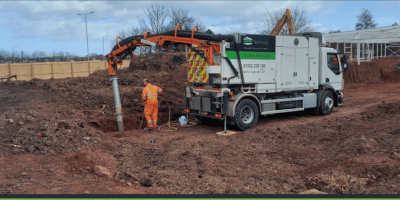Underground Utility Survey Mapping
Technics has been providing effective subsurface utility surveys since 1999, building a reputable solution for a wide range of clients across multiple sectors.
We understand the importance of determining the purpose of your survey right from the start of a project and this knowledge enables our team of project managers to tailor the methodology in line with industry specifications, including PAS 128:2022, and provide cost-effective solutions within your budget.
What is Underground Mapping and how is it Conducted?
Underground utility mapping is a survey using geophysical techniques to create a digital representation of what is buried underground. The survey composes a highly detailed below surface profile using the latest technology, including Ground Penetrating Radar (GPR) equipment, and Electro-Magnetic Locators (EML). This technology is used to interpret reflected signals from structures, services, buried objects, and layers beneath the ground – ultimately providing vital detail required for project planning ahead of any prospective works.
With knowledge and expertise, we know how to overcome any limitations to ensure clients receive thorough, detailed, and accurate results.
Underground utility mapping creates an accurate plan of the subsurface environment in multiple formats including 3D.
With our Vacuum Excavation service, Technics can also expose utilities safely and efficiently to fulfil the PAS 128:2022 specification quality level QL-A.

What are the benefits of Underground Utility Survey Mapping?
Utility maps are important any time you are breaking ground as they show accurate positions of the buried utilities you will encounter. It also helps to prevent digging into or damaging any utilities that may cause harm to the public or your workforce.
- Reduce project planning time
- Minimise risk
- Gain confidence before excavation works
- Comply with the health and safety regulation
- Avoid surprises
- Comply with BSI standard – PAS 128:2022
A Utility Mapping Survey will provide you with the confidence to progress with your project and ensure there are ‘no surprises’ along the way.
Adhering to all health and safety regulations will also ensure you are following best practices for your company and your employees.
Identify ‘safe’ areas for excavation or confirm the safest route for proposed utilities.
Underground mapping minimizes the risk to your workers, neighbours and the public before any excavation works are undertaken. The ability to check as-built information and verify that utilities were laid to specification.
What can go wrong when utility maps are not used?
South Lanarkshire Council were fined after two workers suffered flash burns when they struck an electrical cable while digging a ditch. This could have been avoided if a Utility Survey had been used before the work started.
One man, 59, suffered burns to his arms and face but was spared even more serious injury by his insulated gloves.
His fellow worker, 33, was blown off his feet and received eye burns when the strike happened at a site in East Kilbride four years ago.
You must create a safe working environment by conducting the appropriate surveys before beginning construction.
Where can I find a specification of works for Underground Utility Survey Mapping?
Our industry has collaborated with international bodies to provide a detailed specification of works which will ensure surveys are carried out using skilled, experienced operatives to deliver a high standard of work to clients.
PAS 128
A revision was made to the 2014 PAS 128 specification for underground utility detection verification and location. PAS 128:2022 now includes additional guidance concerning the training and qualifications of practitioners. The updates also include the use of post-processing in detecting surveys. The guidance also provides control for the accuracy of detection methods.
The standard PAS 128 outlines the requirements for detecting, verifying, and locating existing and new underground utilities, including active, abandoned, redundant or unknown ones, and the identification of their associated surface features such as manhole covers and utility markers. This applies in any location, whether it be urban or rural areas, street or private sites like hospitals or airfields.
Furthermore, PAS 128 also specifies the level of accuracy at which the data must be captured, the expected quality of the data, and a means to evaluate and indicate the reliability of such data.
How does Ground Penetrating Radar (GPR) Work?
Ground Penetrating Radar (GPR) equipment transmits an Electromagnetic (EML), or radio wave, pulse into the ground at various frequencies, which are recorded on site. The signal is transmitted and then reflected back to the GPR unit, the quality of the signal in both directions can be dependent on the properties of the material it passes through.
The recorded sections of scanned data (pictured below) are post-processed in the office. Each scan is assessed and analysed for any possible targets (services, anomalies and voids), these are then selected using specialist software and a highly trained surveyor. The output from this software is then integrated into the utility survey model and presented in a concise and easy to understand way.

GPR, unlike more traditional EMLs, can pick up non-metallic objects and utilities in a completely non-intrusive way. This unique feature makes the use of GPR for Utility Surveys almost mandatory in an industry that is increasing its use of plastic piping on utilities.
GPR has more uses than just mapping utilities, with the right equipment and expertise it can be used for the following:
- pavement/bridge/roadway inspection
- void detection
- concrete slab analysis
- rebar mapping
- verifying as-built information of concrete walls and floors
How Technics overcomes GPR limitations
Even though Ground Penetrating Radar is an incredible tool for mapping underground features, it does have the drawback of not being able to accurately identify utility types.
Technics layered and modular approach to utility surveys combines GPR, EML, visual inspection and records to produce the best subsurface mapping information possible without digging. To help complement this further, Technics now employs a vacuum excavation service. This enables us to expose the utilities to provide an accurate visual of their type, depth, and position.
Additionally, we possess expertise and knowledge of GPR systems from the main industry manufacturers such as GSSI, and IDS who created the Stream UP, and Stream DP.
Talk to Our Experts
Chat with us about your project needs and we’ll see how our expertise in underground utility surveys can help your next project run smoothly.
Technics Group has more than 30 years of experience providing high-quality consulting and surveying services with the right technology.
Discuss your needs with our expert team.
Market Insights & Resources

Technics continues to adapt
Excerpt: Technics continue to follow the guidelines from the UK Government to ensure we protect the health of others, especially the vulnerable. Due to the nature of our work, and the technology we utilise, we can work in isolation on site, subject to the environment and…





